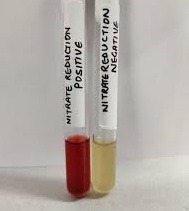The nitrate reduction test is an important biochemical test in microbiology. It is used to differentiate the various gram-negative rods and also mycobacteria.
Nitrate reduction test principle
Some anaerobic bacteria use nitrates in an anaerobic environment. As a result, they produce NITRITE and NITROGEN gas.
Nitrite changes the color of media, while nitrogen gas can be seen in the form of a bubble.
Nitrate reduction test reagents
- Nitrate Agar
- Peptone
- Agar
- Potassium Nitrate
- Distilled water
- Sulfanilic Acid
- Alpha Naphthylamin
How to perform nitrate reduction test
- First of all, inoculate the medium by streaking the slant and stabbing it to the butt with test organism culture.
- Incubate at 35 C for 4 hours.
- Add one drop of sulphanilic acid and one drop of naphthyl amine to the slant.
- Now for a change in color, if red color is seen, the result is positive otherwise negative.
Nitrate reduction test positive result
After incubation for 4 hours, add one drop of sulphanilic acid and 1 drop of naphthyl amine. If a red color appears on the medium, it will be considered a nitrate reduction test-positive result.
What does nitrate reduction test for?
A nitrate reduction test was used to identify the anaerobic gram-negative rod. All Enterobacteriaceae reduce nitrate.
Nitrate reduction test control
Positive Control: E.coli was used as a positive control in the nitrate reduction test.
Negative Control: Streptococcus bacteria use as a negative control in the nitrate reduction test.

